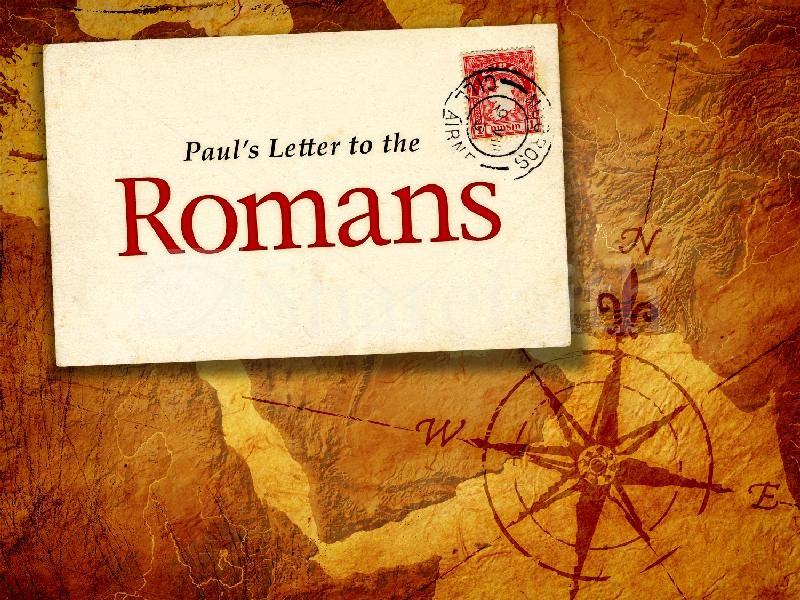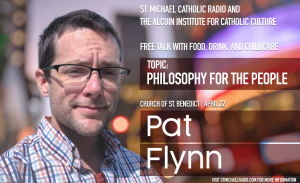Baptism and the “Roman Road”

Baptism Saves you
By: Fr. Dwight Longenecker
Originally posted on Catholic Answers
 Even though I was brought up in a devoutly Evangelical home, I wasn’t baptized until I was 21 years old. We attended an independent Bible church with an essentially Baptist theology, and the irony about this Baptist theology is that it actually de-emphasized baptism. What mattered was being “born again” or “saved,” if we had responded to an altar call and “accepted Jesus into our hearts.” This personal experience was all that was necessary to assure us of eternal salvation. Baptism and communion (while they were not dispensed with altogether) remained unnecessary symbols of our inner faith.
Even though I was brought up in a devoutly Evangelical home, I wasn’t baptized until I was 21 years old. We attended an independent Bible church with an essentially Baptist theology, and the irony about this Baptist theology is that it actually de-emphasized baptism. What mattered was being “born again” or “saved,” if we had responded to an altar call and “accepted Jesus into our hearts.” This personal experience was all that was necessary to assure us of eternal salvation. Baptism and communion (while they were not dispensed with altogether) remained unnecessary symbols of our inner faith.
As a college student, I became an Anglican, and before I could be confirmed, I submitted to baptism. Later I went to teach in a Christian school attached to a Baptist church, and even then the pastor seemed more concerned about the mode of baptism than baptism itself. He insisted that I be re-baptized by total immersion since he didn’t think my Anglican baptism (with water poured over my head) counted.
Travel the Romans Road
I lived in England for 25 years and had little contact with Baptists. Now our family has moved to South Carolina, and recently two Fundamentalist Baptists came around to discuss theology with me. They proceeded to take me along the famous “Romans Road.” This is a simple Evangelical process that leads a person to salvation through the most basic Christian truths taken from St. Paul’s epistle to the Romans.
The first verse is Romans 3:23, “for all have sinned and fallen short of the glory of God.” After establishing that you are a sinner, in Romans 6:23 St. Paul reminds you that “the wages of sin is death.” The second part of that verse gives the promise that “the gift of God is eternal life through Jesus Christ our Lord.” Romans 5:8 tells us that “while we were yet sinners Christ died for us.” Romans 10:13 says that “Whoever calls on the name of the Lord will be saved,” and Romans 10:9 says that “If you confess with your mouth Jesus as Lord, and believe in your heart that God raised Jesus from the dead, you shall be saved.”
My visitors took me through the Romans Road and were a little nonplussed when I agreed with them on every point. I then asked them why they didn’t go any further along the road. They asked what I meant. “St. Paul goes on to say just how this salvation happens,” I replied. “He gives us an objective and solid way to know that we really have been made one with Christ. But first, we agree, don’t we, that salvation means we die with Christ so that we may have new life?”
They agreed.
“How does this happen?” I asked.
“You have to accept Jesus. Believe in him in your heart and confess with your lips.”
“Yes, we Catholics believe that is necessary, but there is more to it than that. In addition to believing and confessing with our lips, we need to be baptized. At the beginning of Romans 6, St. Paul actually explains how we share in the death and new life of Christ: It is through baptism.”
The beginning of Romans 6 says, “Don’t you know that all of us who were baptized into Christ Jesus were baptized into his death? We were therefore buried with him through baptism into death in order that, just as Christ was raised from the dead through the glory of the Father, we too may live a new life.” This idea that we are made one with Christ through baptism is reiterated by Paul in Colossians 2:12, and in Galatians 3:27 he likens baptism to “being clothed with Christ.”
Furthermore, the fuller idea of salvation being a union with Christ fits with much more of the New Testament, which speaks time and again of being in a profound union with the living Lord—rather than simply being saved or justified by a personal belief in Christ.
The sacrament of baptism takes the believer from the simple repentance, belief, and profession of faith into a more mysterious identification with Christ, in which he is the vine, and we are the branches, in which we die with him so that we might rise to new life. Baptism is not simply the addition of a meaningful symbol to the act of faith: It is an action which takes the believer’s whole body, soul, and spirit into a new relationship with God.
Born of Water and the Spirit
The passage in Romans 6 (backed up by Colossians 2) is not the only evidence from the New Testament that baptism is effective and therefore necessary for salvation. The apostles Peter and John confirm St. Paul’s teaching. In Acts 2, when St. Peter is preaching at Pentecost, his hearers ask what they must do to be saved, and he replies, “Repent and be baptized.” In 1 Peter 3, Noah’s ark is referred to as a type of baptism, and Peter writes, “In it only a few people, eight in all, were saved through water, and this water symbolizes baptism that now saves you—not the removal of dirt from the body but the pledge of a good conscience toward God. It saves you by the resurrection of Jesus Christ” (1 Pet. 3:20-21).
The most famous New Testament evidence for the efficacy and necessity of baptism is in John’s Gospel. When Nicodemus comes to visit Jesus by night, Jesus says that a person cannot enter the kingdom of God without being born again. Nicodemus asks how a man might enter again into his mother’s womb and Jesus corrects him, saying, “No one can enter the kingdom of heaven unless he is born of water and the Spirit” (John 3:3-5). From the earliest days of the Church this passage has been understood to refer to baptism, and this interpretation is virtually unanimous down through history.
However, many Evangelicals have a peculiar interpretation for this verse. They say that the “water” in the verse does not refer to baptism, but to the amniotic fluid of the mother’s womb. This is the “water” that breaks at the point of physical birth. Therefore they believe when Jesus refers to “water and the Spirit,” he is referring to physical birth and spiritual re-birth. This might be a possible interpretation as the previous verse was a discussion of a man entering again into his mother’s womb.
However, one must look at the whole passage in its context. It is universally agreed that John’s Gospel is the most “sacramental” in its approach. The passages of Jesus’ life and teachings are put together in such a way as to connect with, and support, the sacramental life of the early Church. In the verses that immediately follow Jesus’ words that one must be “born again of water and the Spirit,” Jesus talks about “men loving darkness rather than light because their deeds are evil” (verse 19) and that whoever “lives by the truth comes to the light” (verse 21). The references to light point to the other main symbol of the baptismal ceremony—the lighted candle. If there is any doubt, the very next story in John chapter 3 shows Jesus immediately going out with his disciples baptizing.
Is It Enough to Believe and Confess?
As soon as you begin to speak about the necessity of baptism, an Evangelical will pull out some favorite verses and favorite arguments. They will go back to Romans 10:9-10, “If you confess with your mouth, ‘Jesus is Lord,’ and believe in your heart that God raised him from the dead, you will be saved. For it is with your heart that you believe and are justified, and it is with your mouth that you confess and are saved.” They will point out that this verse does not say that one must be baptized. The reply is that belief and profession of faith arenecessary, but the whole witness of the New Testament shows us that baptism is necessary as well.
Evangelicals may also refer to the story of the Philippian jailer in Acts 16. The jailer cries out, “What must I do to be saved?” and Paul and Silas reply, “Believe in the Lord Jesus Christ and you will be saved—you and your household” (Acts 16:31). It seems there is no demand for baptism. However, actions speak louder than words because verse 33 says that “immediately they were baptized.” Baptism therefore seems to be the way one makes the faith commitment. This is just one example from the Acts of the Apostles where faith is accompanied by baptism, and it is assumed that both are necessary. Two other clear accounts are Philip’s encounter with the Ethiopian eunuch in Acts 8, and Peter’s immediate baptism of Cornelius and his household in Acts 10. The pattern in Acts is consistent: preaching, repentance of the hearers, belief in Christ, and immediate baptism. Why would this be the case if the apostles did not believe that baptism was both effective and necessary for salvation?
The Evangelical who does not want to accept the efficacy and necessity of baptism has a few more objections. What about people who do not have the opportunity to be baptized? He will bring up the good thief on the cross. The thief couldn’t be baptized, but Jesus says, “Today you will be with me in paradise” (Luke 23:43). This is the perfect opportunity to explain two other.aspects of Catholic belief.
Baptism of Blood, Baptism of Desire
First, you can explain that the Catholic Church does not believe that baptism is magic: Simply having water poured over one’s head with the Trinitarian formula does not mean a person is instantly saved forever. Baptism incorporates the individual into the Body of Christ, and within the whole life of the Church an individual’s baptism must be accompanied by faith. The developing faith of the individual is empowered by the grace of baptism, and nurtured by the whole Church, but if the Christian faith is rejected or never positively affirmed, the baptism is not magically effective.
For difficult cases such as the good thief, it should be explained that the Catholic Church has always taught that there is a “baptism of blood” and a “baptism of desire.” The baptism of blood refers to those who were not baptized but were martyred for Christ. They are incorporated, through their own death, into the mystical body of Christ through a mystical sharing in his sacrificial death.
The baptism of desire refers to those individuals with faith in Christ who would be baptized if they had the opportunity and if they truly understood what baptism means. It applies to those who, due to extraordinary circumstances, do not have access to water for baptism. But the New Testament indicates that what we call “baptism of desire” is the case for the Old Testament saints. Noah and his family were “saved through water” in the flood, (2 Pet. 2:5) and the Hebrew children were baptized “into Moses in the cloud and the Red Sea” (1 Cor. 10:2). This suggests that baptism of desire may also extend to those who have pre-Christian faith or to non-Christians who have faith according to the level of their knowledge, but have never heard the Christian gospel.
It may also apply to those who have faith in Christ, but have not been baptized because they truly and sincerely (because of false teaching received in goodwill) do not believe that baptism is necessary. Even in these cases, however, it should be understood that the Church teaches that such individuals “may” be saved, not that they are saved.
Incorporate It
The most difficult thing for an Evangelical to accept in a conversation about the sacraments is that God actually uses physical means and liturgical ceremonies to dispense his grace and administer salvation. The typical Evangelical is heavily conditioned to dismiss all physical components of religion as useless and distracting “man-made traditions.”
However, the theory doesn’t stand up in practice. It cannot because we have bodies that are in time and space which need a way to respond physically to spiritual realities. It is not very difficult to demonstrate that they believe physical actions and religious ceremonies can be useful for salvation—otherwise why have evangelistic rallies with emotional music and altar calls? Why encourage people to “put up their hand, get up out of their seat, and come forward?” It’s because they realize that we need physical actions, religious ceremonies, and rituals to help us accept the gift of salvation that is being offered, and they must accept that it is through these physical responses that salvation is accepted, and therefore that the physical responses are effective and necessary.
If they can see that God uses their preaching and their traditions and religious rituals to bring people to salvation, then it is not too much of a leap for them to see that the Catholic rituals are another physical and active way for individuals to accept the gift of salvation. Of course, the sacraments are more than a practical, man-made religious tool. The sacraments are not done by us for God, but by God for us. However, moving a non-Catholic to the point where he accepts that a sacrament is useful is the first step towards accepting that it is necessary, and that is just one step away from the acceptance that they are not just man-made, practical religious devices, but divinely instituted initiatives that incorporate the soul into the mystical Body of Christ.


